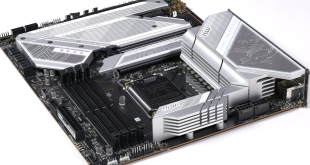Asus Republic Of Gamers products are immediately recognisable, shipping in a bright red box with the famous logo set to the side.
The Asus Rampage IV Extreme is one of five boards that ASUS are releasing today and is the flagship product, just above the P9X79 Deluxe. It is expected to retail for £334.99 and is bundled with a copy of Battlefield 3, although it wasn't featured in our early review sample.
The bundle with this product is extremely comprehensive, and suits a luxury branded board. They include a ROG Connect Cable, 1 x 3 way SLI bridge, 1 x 4 way SLI bridge, 1 x SLI cable, 1 x Crossfire cable, 1 x 2 in 1 Q connector Kit, 2 x 2 in 1 SATA 3GB/s cables, 2 x 2 in 1 SATA 6GB/s cables, 1 x I/O Shield, 1 x 12 in 1 ROG Cable labels, 1 x Probelt cable set, 1 x OC key, 1 x OC key cable and a socket pad module. Phew!
The board is built around a black PCB with red accenting on the slots and ports. This board measures 30.5 cm x 27.2 cm fitting the ATX standard.
The board is populated with mean looking black heatsinks to help ensure stability when overclocked to the limit. This board is actively cooled, with a small fan visible at the bottom right of the PCB layout.
The Rampage IV Extreme Edition board is catered towards hard core overclockers and has an 8 phase CPU power implementation, with 3 phase QPI/DRAM power, 2 phase NB power and 2 phase memory power. Along the top of the board, next to the memory slots are various tools to aid with overclocking and trouble shooting. There is also a power on and reset button here for quick, easy access and an LED for diagnostic readout. Asus include a PCIe x16 Lane Switch so users can disable and enable the corresponding PCIe x 16 slots.
The hard core overclocking audience will certainly like the ‘slow mode' switch which can be used when benchmarking with LN2. Asus say “Some processors have a small optimum temperature range to run at their highest frequency. Warmer or colder yields instability at this frequency. For example, a certain processor may need -80c loaded in order to run at 5.8ghz, which means about -75C idle in order to stay stable at 5.8ghz.
Going colder or warmer crashes. It will however remain stable at slower frequencies at much coler or warmer temperatures. Once it comes out of heavy load while transitioning over to a light load, when the temperature does not warm fast enough, it may crash. To over come this simply flip the switch over to ‘slow' the processor instantaneously. Switching over to Slow-Mode during critical moments when Temperature/Max Frequency alignment is off-synch saves a lot of crashes, even when trying to boot into the OS at cold temperatures.”
The Asus Rampage IV Extreme can accept up to 64GB of memory at speeds of 1066 mhz / 1366mhz / 1600 mhz / 1866 mhz and also OC settings of 2133mhz and 2400mhz. As with all X79 boards the Rampage IV Extreme supports a Quad Channel memory architecture.
The Rampage IV Extreme supports 4 way SLI and 4 way discrete CrossfireX for the ultimate gaming performance. It has four PCIe 3.0 x 16 slots (red) which support x16, x16/x16 and x16/x8/x16 and x16/x8/x8/x8 configurations. There is also a PCIe 3.0 x 16 slot (black) which supports x8. At the bottom is a single PCIe 2.0 x1 slot.
There are eight SATA ports on the board. The two ports above at the far left (coloured red) are controlled by the ASMedia chip and run at SATA 3 (6GB/s speeds). The two red ports next to the black SATA ports are also SATA 3 (6GB/s) capable but are powered from the onboard Intel X79 chipset. The four black ports on the right are also controlled by the Intel X79 chipset, but run at SATA 3 speeds (3 GB/s). The little black ‘box' at the edge of these ports is the ASUS ‘Subzero Sense connector'. This allows for the connection of a K probe cable (bought separately) to measure motherboard temperature via BIOS, OC Key or Turbo V EVO, without having to purchase a multimeter.
The back I/O panel has connectivity for: 1x PS/2 keyboard/mouse port, 1x clr CMOS switch, 1x ROG Connect on/off button, 2x external SATA 6.0 GB/s ports, 1 x LAN (RJ45) port, 1 x Bluetooth v2.1+EDR module, 4x USB 3.0/2.0 ports (blue), 8 x USB 2.0/1.1 ports (1 also for ROG connect) and finally support for 7.1 channel audio with an optical S/PDIF I/O.
 KitGuru KitGuru.net – Tech News | Hardware News | Hardware Reviews | IOS | Mobile | Gaming | Graphics Cards
KitGuru KitGuru.net – Tech News | Hardware News | Hardware Reviews | IOS | Mobile | Gaming | Graphics Cards















